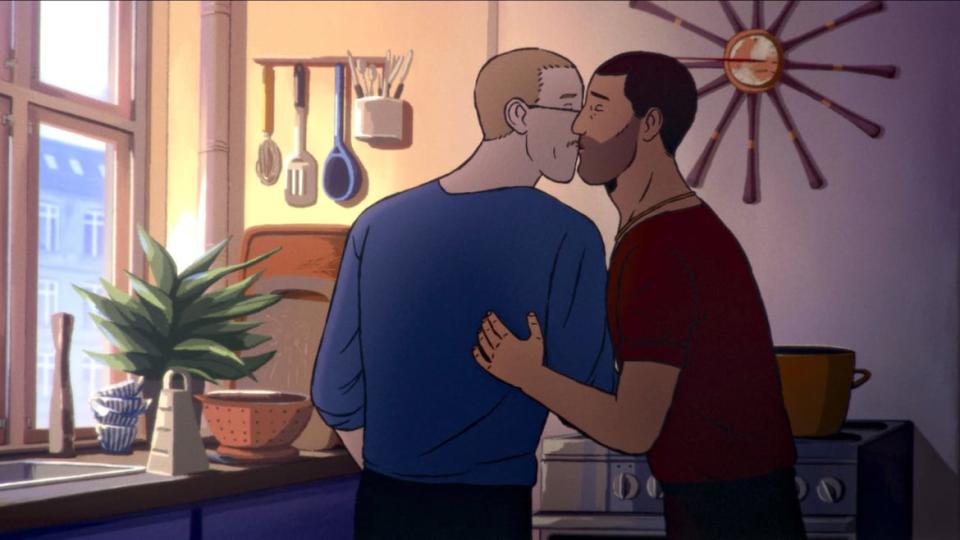‘Flee’: A Gay Afghan Refugee’s Haunting Story Comes to Stunning Life

In the absence of filmed visuals, the sounds in Jonas Poher Rasmussen’s animated documentary Flee become our tether to reality. Narrator Amin Nawabi details his family’s escape from Afghanistan in the 1980s with a faraway tone that evokes an unsettling dream. A haunting cacophony of clanging metal punctuates his story—like refugees banging on the walls of a shipping container, frantic pleas to escape the very thing that was supposed to set them free.
As a small child fleeing the only home he’d ever known, Amin witnessed humanity at its cruelest—from the mercenary human traffickers who locked his family members into cargo hulls for days-long voyages at sea, to the callous immigration officials whose grasp they all sought to evade. His family escaped to Moscow, where they spent years seeking asylum in Scandinavia—a destination they would not reach together. Flee documents the true story of Amin’s journey, which he’s kept secret for decades.
Spielberg’s New ‘West Side Story’ Almost Achieves Perfection
We first see Amin’s animated stand-in lying down for an early interview, one we can tell will be the first of many. His posture is confessional but his tone is wary, hesitant. Soon enough we realize that Jonas Poher Rasmussen and Amin are friends, and that we’ve been privileged with the kind of confidence it takes years to earn. The Danish-French filmmaker combines pseudonym and animation to protect a personal history so troubled that until recently, the man who lived it couldn’t share it with anyone.
Like many people with traumatic histories, Amin has gotten used to telling a very particular version of his story. In fact, “Amin” is not our protagonist’s real name. Drawn with an angular face, 5 o’clock shadow, and a deeply creased brow, Amin himself sounds exhausted before we’ve even begun.
Despite animation’s frequent association with children’s programming, a growing number of films have used the technique to explore traumas both personal and political. Some of the genre’s best-known entries include 1988’s Grave of Fireflies, 2007’s Persepolis, 2008’s Waltz with Bashir, 2019’s Funan, and last year’s My Favorite War. Flee is another triumph in this tradition, and uses the full emotional scope of its artistic medium to capture the humanity of Amin’s story in all its whimsy and terror.
When Amin recalls his youth, we observe a combination of playful animation and news footage from a pre-Taliban Kabul. Poher Rasmussen, animation director Kenneth Ladekjaer, and art director Jess Nicholls favor gently rendered, mostly realistic visuals. But unexpected textures and adjustments in coloration puncture the narrative in times of trauma.
There are also moments of beauty. While Flee largely focuses on the outer circumstances of Amin’s life, we also bear witness to an inner journey as he describes grappling with his queer identity. Amin knew from a young age that he was attracted to men, but it took him years to process what that really meant. His recollections of hiding and detention contain glimmers of that inner exploration as well—of his childhood obsession with Jean-Claude Van Damme, and the minor crush he developed on a fellow refugee while a gruff and expensive human trafficker smuggled them out of Moscow.
Flee’s greatest triumph, however, is its ability to transcend time—to evoke the wide-eyed worldview of a small child on screen while its narrator pieces together his story with the (relative) emotional clarity of an adult. Through young Amin’s eyes, police and human traffickers are indistinguishably terrifying. In adult Amin’s reflections, the monstrosity of national borders as tools of oppression becomes undeniable. But the fragility of Amin’s story, the layers of mediation required for him to share it, is perhaps most telling of all. Even now, there’s a part of him that doesn’t feel safe. It’s why we’ll never know his name.
Get our top stories in your inbox every day. Sign up now!
Daily Beast Membership: Beast Inside goes deeper on the stories that matter to you. Learn more.

 Yahoo Finance
Yahoo Finance 